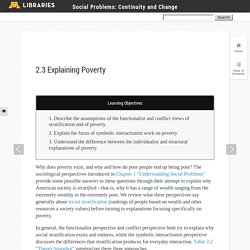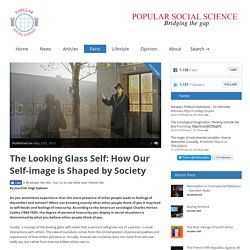

Social Problems: Continuity and Change. Learning Objectives Describe the assumptions of the functionalist and conflict views of stratification and of poverty.Explain the focus of symbolic interactionist work on poverty.Understand the difference between the individualist and structural explanations of poverty.

Why does poverty exist, and why and how do poor people end up being poor? The sociological perspectives introduced in Chapter 1 “Understanding Social Problems” provide some possible answers to these questions through their attempt to explain why American society is stratified—that is, why it has a range of wealth ranging from the extremely wealthy to the extremely poor. We review what these perspectives say generally about social stratification (rankings of people based on wealth and other resources a society values) before turning to explanations focusing specifically on poverty. Table 2.2 Theory Snapshot The Functionalist View Some jobs are more important than other jobs. The Conflict View. Prince Ea. Unified Soul Theory. The Looking Glass Self: How Our Self-image is Shaped by Society. By Joachim Vogt Isaksen Do you sometimes experience that the mere presence of other people leads to feelings of discomfort and tension?

When not knowing exactly what other people think of you it may lead to self-doubt and feelings of insecurity. According to the American sociologist Charles Horton Cooley (1864-1929), the degree of personal insecurity you display in social situations is determined by what you believe other people think of you. Cooley´s concept of the looking glass self, states that a person’s self grows out of a person´s social interactions with others. The view of ourselves comes from the contemplation of personal qualities and impressions of how others perceive us. The main point is that people shape their self-concepts based on their understanding of how others perceive them. The concept of the looking glass-self theory constitutes the cornerstone of the sociological theory of socialization. Building a strong self-image Further reading. Ways of Thinking...: Teacher Resources. Hello fellow teacher, About MeI have been teaching high school sociology at Stevenson High School since 1999.

I teach a one-semester intro to sociology class there. I have also been working with the American Sociological Association as a member of their High School Advisory Board (more info about the ASA below). Additionally, I have been working with a group of high school teachers called the Chicago Area Sociology Teachers (CAST). I did my undergrad at Loyola University and then I earned an M.A. there in Chicago Studies, an interdisciplinary urban studies program with a focus on Chicago.
This startup will pay for your dream wedding — but only if you're willing to bet you won't get divorced. A new Seattle startup says it’s about to offer a way for couples to gamble on whether or not they really found everlasting love.

The premise is simple: you apply if you’re about to get married and think your partnership is built to last. SwanLuv looks at your relationship, forms its own opinions, and then selects certain couples for a loan up to $10,000. If you and your spouse live happily ever after, you never have to pay back the money. But if you someday get divorced, you have to pay back the original amount — plus interest. SwanLuv CEO Scott Avy says it’s like a casino for marriages. He says he doesn’t hope any marriage ends in divorce, but the fact is that some will. Teaching High School Sociology: AP Sociology? Last night I had a Twitter post and back with AP_Trevor about creating an Advanced Placement Sociology course from the College Board.

We shall see what comes of it. Perhaps we need to push more for this course. Here is the link for the ASA proposed AP Sociology course: Teaching TSP. As many Sociology and Feminist blogs are writing, it’s that time of year.

The racist, classist, homophobic, sexist tendencies and expressions make me cringe. This morning, for my Soc 101 class — a large lecture setting of over 150 students — I decided to offer an extra credit project. As discussed previously, students struggle with this large GE style class. I like to offer meaningful, analytical extra credit projects through out the semester. I use Allen Johnson‘s text called, Forest & the Trees, Sociology as Life, Practice, and Promise and we are about to begin the inequality chapter. I want to give a shout out to the scholars, blogs and websites that had all the material available. :-) I would love to keep adding to this assignment and publish a bit earlier in the fall for next year. PS — My own kids are going trick-or-treating as twin witches.
The Sociology of Halloween 1) Watch the video and read the overviews… 2) Learn about what is wrong with “black face” costumes here: 22 Normal Trends In 2005 That Are Totally Weird Today. Cyber Seniors.
Crime. Unit 1: Beginnings. An Introduction to Sociology. Mrs. Savino Mulcahy's Course Website - Sociology. The Basis of Culture Culture consists of the knowledge, language, values, customs, and physical objects that are passed from generation to generation among members of a group.

It defines how people in a society behave in relation to others and to physical objects. Although among animals most behavior is determined by instincts, human social behavior is learned. Sociobiologists try to find a relationship among heredity, culture, and behavior. Language and Culture One very important medium for transmitting and teaching culture is language. The hypothesis of linguistic relativity states that our idea of reality depends largely upon language; that is, our perceptions of the world depend in part on the particular language we have learned.
Norms and Values Two essential components of culture are norms and values. Beliefs and Material Culture Along with norms and values, beliefs and physical objects also make up culture. Families are Unfair! Every once in a while, an academic suggests something upside down, wrong-side up.
